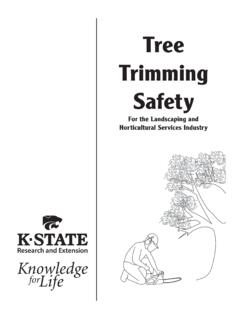Transcription of Universal Precautions / OSHA
1 Copyright 2017 KenCrest Services Universal Precautions / osha Copyright 2017 KenCrest Services What is osha O Occupational S Safety and H Health A Administration Copyright 2017 KenCrest Services Universal Precautions Blood and certain body f luids are assumed to be possibly infected and Precautions are taken universally in all potential exposure situations. These Precautions are written in accordance with guidelines established by the Center for Disease Control (CDC) and osha . These apply to all personnel.
2 Copyright 2017 KenCrest Services Categories of Germs Bacteria (Strep, Staph, e-coli) Fungus (Ringworm, Thrush, Yeast, Mold) Viruses (Common Cold, HBV, HIV) Parasites (Malaria, Fleas, Ticks, Lice) Copyright 2017 KenCrest Services How are Germs Transmitted? Five Modes : Airborne (Legionaires Disease) Droplets (Cold, Inf luenza, TB) Blood and Body Fluids (STD s,HBV,HIV) Skin to Skin (Pinkeye, Ringworm) Oral/Fecal (Hepatitis A, Food Poisoning, e-coli) Copyright 2017 KenCrest Services Links in the Chain of Infection Infectious Agent germs/microbes that cause disease Reservoir carrier or host Portal of exit the way I.
3 A. leaves the host Mode of transmission Means of traveling (on hands) Portal of Entry the way enter the body Susceptible host person with low resistance Copyright 2017 KenCrest Services What are Bloodborne Pathogens? The 3 we are most concerned with are: Hepatitis B HBV Hepatitis C HIV - AIDS Copyright 2017 KenCrest Services Hepatitis B Virus Extremely contagious. Causes: Inf lammation of the liver Jaundice Fatigue Loss of Appetite Abdominal Pain About 10% of those infected become carriers.
4 Can live outside the body for up to 2 weeks. There is an effective vaccine!! Copyright 2017 KenCrest Services Hepatitis C Virus Very contagious. Initially causes symptoms similar to HBV. 10,000 people die from HCV-related chronic liver disease every year. Can live outside the body for 3-4 days. About 85% are chronically infected carriers. There is no vaccine!! Copyright 2017 KenCrest Services Human Immunodeficiency Virus HIV attacks the immune system, eventually destroying the body s ability to fight infection.
5 800,000 people in the USA are HIV positive. Many appear healthy and lead normal lives for years. Eventually leads to AIDS! There is no vaccine and no cure!! Copyright 2017 KenCrest Services Body Fluids which require Universal Precautions : Blood Any body f luid with visible blood Wound secretions Vaginal secretions and semen Copyright 2017 KenCrest Services Body Fluids which DO NOT require Universal Precautions Urine Feces or stool ( with no visible blood) Saliva (with no visible blood) Sputum/mucous (with no visible blood) Vomit (with no visible blood)
6 Sweat Tears Copyright 2017 KenCrest Services Potential Infections Even though you can t get HIV, HBV or HCV from these body f luids they are still a potential source of many other types of infection. Practice Universal Precautions when handling anything which may have been contaminated. Contact with these is NOT considered an Exposure Incident. Copyright 2017 KenCrest Services Procedure Related to Direct Care PPE (Personal Protective Equipment) is used anytime exposure to blood or OPIM (other potentially infectious material) is possible.
7 The type of protective equipment used must be appropriate for the situation. Every home/site must have an osha kit and sharps container. Copyright 2017 KenCrest Services Exam Gloves Exam gloves of latex, vinyl or other non-allergenic material MUST be worn by staff when performing tasks which involve handling blood or body f luids. Gloves must be removed and discarded after each use. Take care to remove them by peeling them down without touching the outside, ball them up and discard. Then wash your hands. Copyright 2017 KenCrest Services Personal Protective Equipment Copyright 2017 KenCrest Services osha Kit / PPE Masks or Face shields to protect against splashes or droplets of through the mucous membranes of the eyes, mouth or nose.
8 Gowns disposable paper gowns or aprons to protect against clothing becoming contaminated. Utility gloves like thick plastic or vinyl gloves CPR pocket mask Copyright 2017 KenCrest Services Wear your It s your last line of defense against infection Copyright 2017 KenCrest Services Open Wounds or Cuts Any open cuts, scratches or sores must be kept covered, unless specified by a doctor, and protected from coming into contact with others. Staff with cuts or skin irritations on their hands are to keep them covered with gloves when coming in contact with any body f luids.
9 Copyright 2017 KenCrest Services Handwashing It should be done : At the start of the day or when soiled. Before contact with food. After using toilet facilities or assisting with personal hygiene. After coming into contact with any Potential Infectious Material, *even if gloves were worn.* After handling or feeding pets. After working or playing outside. The most effective means of preventing disease transmission Copyright 2017 KenCrest Services Handwashing Procedure Use liquid, pump soap. Rub hands together vigorously under warm running water for 30-40 seconds, between fingers and under nails.
10 Rinse. Use paper towel to turn off the faucet after drying your hands. Copyright 2017 KenCrest Services Copyright 2017 KenCrest Services Copyright 2017 KenCrest Services What is an Exposure Incident? An exposure incident involves blood or OPIM coming in physical contact with another person through a cut, puncture or other non-intact skin or by means of a splash to the eyes, mouth or other mucous membrane. Copyright 2017 KenCrest Services Managing Exposure Incidents Immediately wash hands and other skin surfaces that are contaminated.


